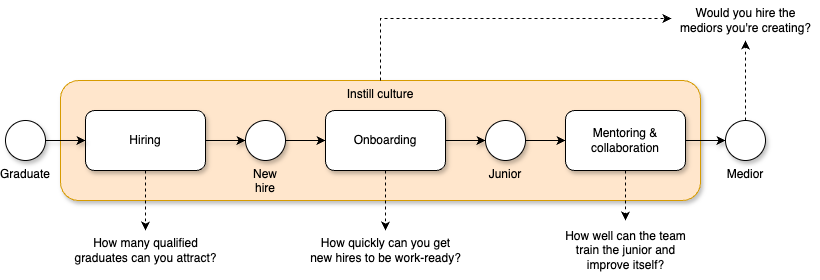Juniors are underrated
Junior colleagues can provide unique benefits that experienced employees don't. Being able to raise them to seniority tells you a lot about your organization's health.
👋 Hey, I’m Milan. This is Organizing Automation, my newsletter on building state-of-the-art digital products and the organizations that deliver them.
With higher interest rates and increasing global uncertainty, many organizations take a conservative stance on making investments. Fewer new projects, fewer external consultants and… fewer juniors. While there is still a need for new employees, there’s a preference for those that are at medior or senior level. The underlying idea is that these employees cost less to get started. This is true, but not the full story. In this article, we will dive into what junior employees bring to the table and why it is absolutely worth it to hire them alongside mediors and seniors.
Junior perspectives
Juniors are typically just out of college with little or no work experience in software. They require mentoring to make sense of how code works in the context of a real company rather than assignments at school. Their initial performance is less than that of a senior, and they will need mentoring by a senior as well, increasing the costs. But juniors also have unique advantages to offer.
Juniors bring the newest insights from their recent education. They will provide a completely different perspective from more senior colleagues who are (almost by definition) older. Software development is all about change: having people aboard that started their software development journey at different times will provide broader insights. Newer insights are not necessarily better than those that your seniors bring, but they are different, meaning they can cause different discussions that lead to improved shared understanding. If you believe in diverse perspectives collaborating to receive the best results, do not underestimate age diversity.
In addition, juniors come with a clean slate: no baggage from previous corporate jobs or ideas of “we’ve always done it this way”. You will have to explain your ways of working and any difficulties surrounding it, after which you can be challenged. Lack of experience is not always a disadvantage, it can also create genuine new insights.
Along these new perspectives, juniors bring a fresh breath of energy to a team. Years of operating in an industry makes you realistic about what can be achieved within a corporation. Someone without that experience, eager to do their best, can renew motivation to tackle any rigid, suboptimal ways of working that a team has adopted. Ambition is contagious and your newest colleague can keep the rest of your team ready for action as well.
Mentoring builds leadership
The time spent training is not just an investment into the trainee - it helps the trainer as well. When you’ve built up your own expertise, the next level is to transfer that expertise to others around you. This requires a completely different skillset than your technical work. While a newly hired senior will also require some help understanding your specific context, juniors need more assistance in general software development practices. This brings new questions: when do you delegate and when do you pair? And how quickly can you see what specific knowledge the junior teammate needs to improve their productivity?
Mentoring is a core aspect of leadership and I firmly believe that being a senior involves being able to help raise up juniors. Any organization benefits from cultivating leadership within development teams as it improves self-management. And while a team lead can take up the mentoring of a junior initially, this task can also be shared together with others in the team who want to grow in their own leadership abilities. The presence of the junior is an opportunity to strengthen the rest of your team.
The team improves because of the junior, but so does the broader organization. Read on to understand how.
The organization shapes the junior
All of the advantages of juniors mentioned above require that the right juniors are hired: not just anyone will do. Hiring is a core process for any organization and being able to spot the right talents early and getting them in the door is a challenge. Junior employees should be hired primarily on potential and ambition rather than knowledge and track record. This also means that your offering needs to be exciting enough for ambitious young people. If you believe your organization does great work, being able to present such an offer that you get a response to should be doable.
Once you have hired the right people, the next task is to onboard them. Getting a new hire ready to contribute is potentially cumbersome and expensive. Especially in organizations with lots of engineers, it is worth investing in a fast onboarding. The sooner someone can start meaningfully contributing in the way you want them to, the cheaper it is for the organization.

Hiring, onboarding and mentoring juniors the right way will make them happy to work for organization. During all these processes, you must instill your culture into their work attitude. Your junior colleagues are a great barometer to see how healthy your company is: if these ambitious people turn into great mediors and seniors, that is a good sign. If they turn into bitter developers or leave the organization within a year, you may have work to do. As long as code is written primarily by humans, their lived experience will be an important indicator of the speed and quality with which your organization can build.
It is easy to claim that hiring juniors is simply too expensive for your organization. Confront yourself and ask: what is the reason my organization cannot find new, ambitious employees and cultivate their talents for an acceptable price?
In the next edition of the blog, I’ll focus on improving a development team’s onboarding experience. Subscribe (for free) to be notified when it is published.



